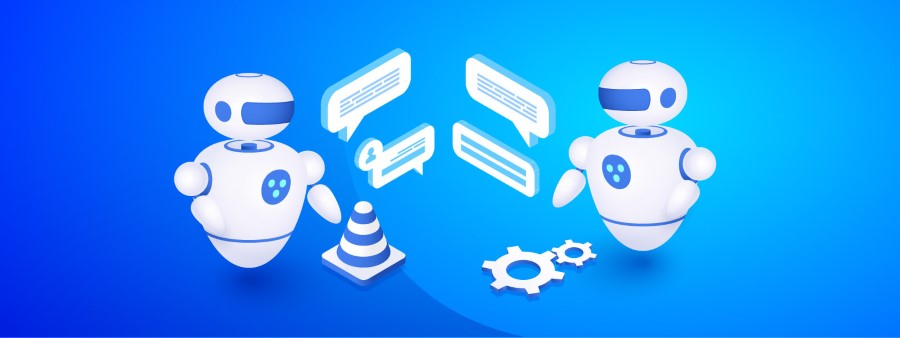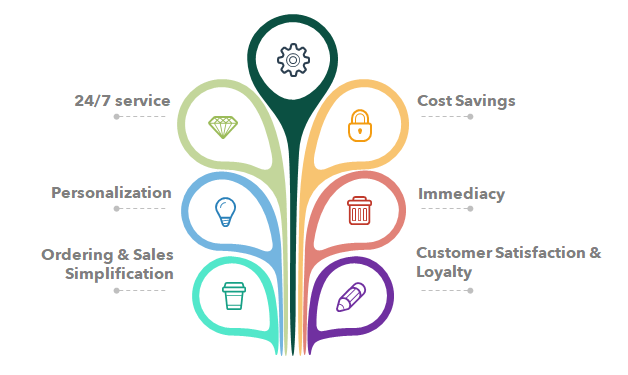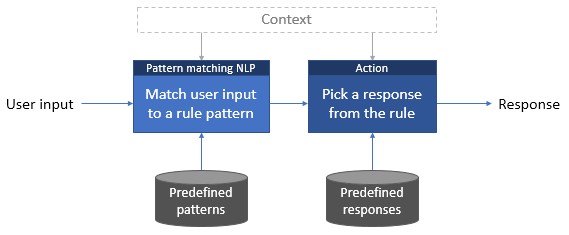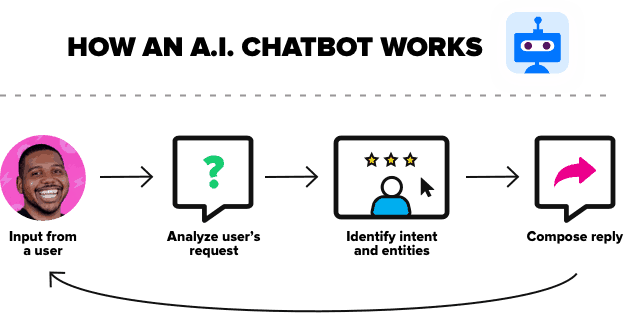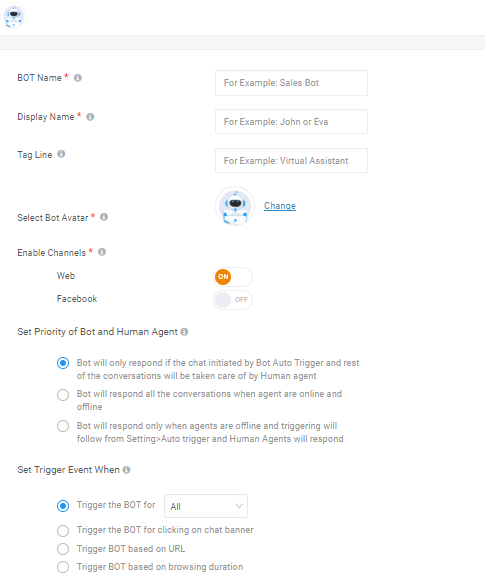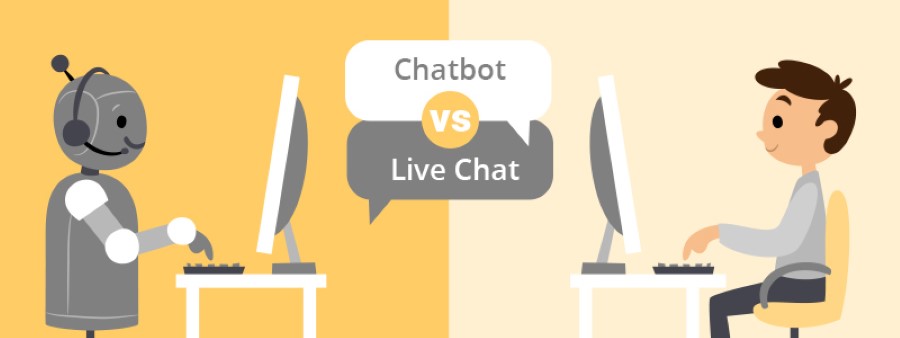Touted by many as the next big digital frontier, the conversational interface helps businesses to move customers down the sales funnel without much effort, improving customer experience and building better engagement through a more humanized interaction.
Chatbots have become the essential tool for businesses to break into conversational UIs, they are an onramp to building artificial intelligence. 71% of customers already expect brands to provide customer service and 66% also expect them to offer personalized CX – over messaging channels.
Hence, having a chatbot as part of your customer service strategy is important. But how can you build one? By implementing the chatbot’s best practices, you can effectively build a conversational-driven chatbot that satisfies your business needs.
How Do Chatbot Best Practices help to Build The Right Bot that Benefits Your Business?
Chatbot benefits businesses to strengthen their customer relationships along with many other significant benefits. Let us take a look at how building the right chatbot can impact and can contribute to your business.
- Increase customer engagement – Brands that engage with their customers in real-time are able to increase customer spending by 20% to 40%. Bots allow you to start a proactive conversation and engage users 24×7 to deliver higher satisfaction.
- Automated customer support – Bots can handle more conversations simultaneously so that no customer has to wait. Your business can also use a chatbot template for welcome greetings and add value to conversations.
- Better lead generation – Bots can prequalify leads by asking relevant questions and helping in generating leads. A chatbot for sales ensures that the leads are directed to the right team for proper nurturing and conversion into sales.
10 Chatbot Best Practices to Be Followed for Designing Bots
Businesses that focus on adopting chatbot technology may be eager to know the best practices and strategies to build a bot that meets their business requirements.
Here are the top chatbot best practices for building and implementing them successfully.
1. Define Your Objectives
One of the best practices for designing a chatbot is to outline your goals clearly before you even start building it. It helps you to understand the queries or questions your customers might be expecting by using the chatbot.
Your goals should be able to answer the following questions:
- What is the main objective of building a chatbot? Is it for lead generation, marketing, or customer support?
- Who is your target audience? Are they new visitors, existing visitors, or returning visitors?
- What is the specific time you want to deliver bot support? For 24×7 support or specific hours?
There are specific tasks that chatbots can handle smoothly. The conversational design allows bots to collect important information from users and provide a relevant, useful service to customers. While defining your goals consider your chatbots’ potential and plan how to enhance the conversational experience.
2. Identify Your Target Audience
The key to building a chatbot successfully requires a deep understanding of your target audience, behavior, and expectations. You should be able to figure out your user base and the utility of the bot for the target audience.
Identifying the target audience can help you in the following ways:
- To understand your customer’s needs and problems
- Prepare the UI/UX flow that addresses the expectations and issues of your target audience
- Understand how the bot will interact with them across the conversations
Note: Classifying your audience is vital to gain insight that will help you keep your chatbot’s best practices and deliver an effective experience. By identifying the purpose, you will be able to build the bot to match your customer’s intent.
3. Choose the Right Type of Bots
Business requirements differ in sectors and sizes. It is very important to identify the type of chatbots to be used to engage customers effectively. First of all, you need to understand how a chatbot works to determine the right chatbot for your business. There are two main types of chatbots.
Rule-based chatbots
Rule-based bots also known as command-based or scripted bots rely on predefined paths, scripts, and dialogues during customer conversations. The user has to pick from explicit options provided by the bot during the conversion and will determine the next step in the conversation.
Conversational AI chatbots
Conversational bots are also known as virtual or digital assistants. They use Natural Language Processing (NLP) technology to determine the intent in singular interactions. These bots are intelligent enough to understand the user’s request and provide an appropriate response.
Pro tips:
- If your business requirements are simpler it is better to choose the rule-based chatbots as it follows predetermined rules and is easy to use.
- For businesses with complex scenarios, AI-enabled bots are suggested as they can interpret the context and answer accordingly.
REVE Chat brings a host of customer engagement tools such as live chat and chatbot that can help you drive user interactions. Sign up to get the top-rated customer service software and put your support on auto-pilot.
Note – Rule-based chatbots are highly recommended as they can create a better fluid chat experience. One chatbot’s best practice is to provide options to your users during the conversation. It saves a lot of time and allows for seamless conversations.
4. Focus on UI/UX for a Better Experience
It is vital to be customer-centered while designing the bot flow to add great value. The main objective is to reduce user efforts with clear messages and deliver a great experience. During the conversation, your chatbot should be capable of engaging visitors with quick answers and solutions.
While building a dialog tree, you need to ensure that every possible user request is covered by a part of your chatbot’s logic and the user would not get stacked at some point. You can convert the scenarios into small steps known as a node with the help of different actions to build the bot flow. The actions could be:
- Setting a warm welcome greeting
- Collecting visitor information
- Providing different options to the user request
Protips to make your chatbot flow conversational:
- Make the flow interactive by adding visuals in the form of videos, emojis, and gifs.
- Reduce friction with conversational bots. They have open interactions, understand your customer needs better, and collect more valuable data.
- Give your customers a way to talk to a human. If you think that you may miss something, simply leave the option to contact a human agent to avoid a dead end.
5. Pick up the Right Platform
There are many platforms where chatbots can reside. The best way to decide on the platform for your chatbot strategy is to identify the use cases depending on your business requirements. You can choose one of the two ways to build chatbots. They are:
Ready to use a chatbot platform
Businesses that go with ready-to-use bot platforms save both effort and time. Some key attributes of a readymade bot platform are as follows:
- Easy usability – Readymade platforms include a predefined chatbot template for lead generation, which simplifies the process of creating a bot and deploying it across multiple channels.
- Zero coding – When there is no coding required you can build your chatbot effortlessly to engage your customers.
- Transfer to a human agent – A bot platform that comprises the strengths of live chat and chatbot to handle conversations efficiently. Bots can answer common queries and complex ones can be handed over to the support agents.
- Extensive analytics – With bot analytics, you can measure your customer satisfaction and the total number of searches your bot answers. These metrics help you to identify the key queries so that you can train your bot accordingly.
- Security – Bots collect plenty of customer information and store conversational data that consists of sensitive details. Businesses should follow safety measures to protect these data to maintain trust.
Custom development
When businesses have specific requirements or complex use cases, it is recommended to build a customized bot. You can design your nodes and bot flow that will match your business requirements. The readymade bot platforms may not quench specific solutions needed by your business.
6. Tailor Your Bot Personality
A chatbot is an additional way of interaction between your customer and your brand. This is why this experience must be consistent with the other elements of your brand’s style.
Why is a bot’s personality, and tone of voice so important while building a chatbot?
Because apart from the visual interface, your bot will use conversation. In this context, the tone of voice you apply and the bot name you choose should resonate with your brand’s communication style and the expectations of your target audience.
Chatbot personality creates a deeper understanding of the end objective, and how the bot will communicate through a choice of language, tone, and style. Enhancing the chatbot personality makes it authentic and relevant to your users. It embodies two main areas:
- Branding – You can infuse your brand voice into the bot persona to engage customers in a personalized manner. Give a unique name to your bot to make the customer feel like talking to a human agent.
- Messaging – Configure warm greetings to start a healthy flow of conversations. You can guide your visitors about the product and services with a well-framed message.
Note: If you want to add more personality, you simply create the bot’s character with a story. However, bots with personalities should never imitate humans. It is more about a personal touch. Writing a script, keep the bot’s personality in mind. Thus, your chatbot’s messages will convey its emotions, behavior, and temper.
7. Focus on Fallback Scenarios
Fallback scenarios are a very important part of chatbot UX best practices. Fallback scenarios identify the breakup points in the conversation and define an alternate solution that the bot can offer to the users. Ensure that you have well-defined fallback scenarios while designing chatbots.
Every user expects an instant relevant response and if the bot is unable to fulfill the requests with relevant answers it is not fit for such scenarios. and a fallback scenario can be properly outlined so that the users don’t leave frustrated.
Here are some fallback scenarios when the bot makes mistakes or fails to deliver the relevant response:
- Transfer to human support– If the bot is unable to identify the intent of the user request, it can be handed over to the human agent.
- Fill up a form – The bot can either offer a form to the user to fill up the fields mentioned to be contacted again.
- Leave a message – The bot can request the users to leave a message for the agent to acknowledge when available and revert them back with the right solution.
Note: Defining the fallback scenarios helps to end conversations on a positive note.
8. Deliver Hybrid Support
Both live chat and chatbot are two great channels for real-time customer engagement. Once you thoroughly understand the differences between chatbots and live chat, it would help you to decide how to use them both to deliver a conversational experience.
Businesses need to identify their customer preferences and use both channels in a balanced way to deliver automated conversational support. Businesses whose priority is instant response and 24×7 availability can use chatbots as the first point of interaction to answer FAQs. The complex conversations that need human involvement can be handled by live chat agents.
Follow the best practices for chatbots:
- Provide your customers with the powerful hybrid support of both live chat and chatbot. Bots can handle FAQs and humans can handle complex queries.
- Create an easy way for your users to connect with your support team. This will increase user engagement and boost customer satisfaction.
Note: It is recommended that businesses can implement both channels together to deliver a hybrid customer support experience.
9. Test Test and Test
One of the key factors for the success of any chatbot is continuous improvement and that can be achieved through testing. Once the chatbot is deployed, closely monitor the initial interactions and gather feedback to understand how users are interacting with the bot.
Gathering user feedback and adding them to your bot’s arsenal can improve user interaction over time.
Components that you can consider for testing your bot:
- Is it not possible to understand the intent of your customers and provide relevant answers?
- Are your customers satisfied with your bot conversation?
- How many fallbacks are occurring?
These components have to be reviewed from time to time and improvements can be made to make your bot more interactive and accurate.
10. Measure Your Bot Performance
Once you build your chatbot, you will surely want to know how well your chatbot is performing. To monitor its performance, you need to measure it. Measuring the chatbot KPIs helps to understand if the user experience with the chatbot was good or not. You can also keep an eye on the way your customers interact with the bot.
The key metrics to measure bot performance are:
- Total conversions – Monitor how many conversions you gain through your chatbots and whether you can attribute any spikes to specific campaigns.
- Successful bot conversations – These refer to the conversations handled successfully by the bot without human intervention.
- Total human handover – It refers to the total conversations that are transferred by the bot to the human agents. It shows how capable the bot was to engage the customers by answering their queries.
- Customer satisfaction – With CSAT or NPS surveys, you can calculate the score and know how satisfied your customers are with your bot responses.
How measuring chatbot performance helps to improve user experiences?
- If customer satisfaction is low, it indicates that users are not happy with the bot interaction. And if it is high, it means the bot you have designed is meeting the customer’s expectations.
- It helps you to understand if the bot is meeting the end goal or purpose with the intent it was built.
- If the total human handover is huge, it means the chatbot is not smart enough to understand the user queries and deliver relevant responses.
Final Thoughts
When you go stepwise you will gain a concrete understanding of why you need a bot. The entire journey will help you find out what a bot should do and how it should work. The above chatbot best practices will help you to build, deploy, and improve your bot successfully.
You can start a free trial of the chatbot and take the right step towards adding great value to your customer engagement effort.
But yes, you need to understand how a well-converting bot requires smartly structured decision trees, great copy/conversation writing, tool integrations, and attractive design and that’s just to start with.
Further with your chatbot you will unveil opportunities and unlock a new channel of communication between your brand and your customers.
